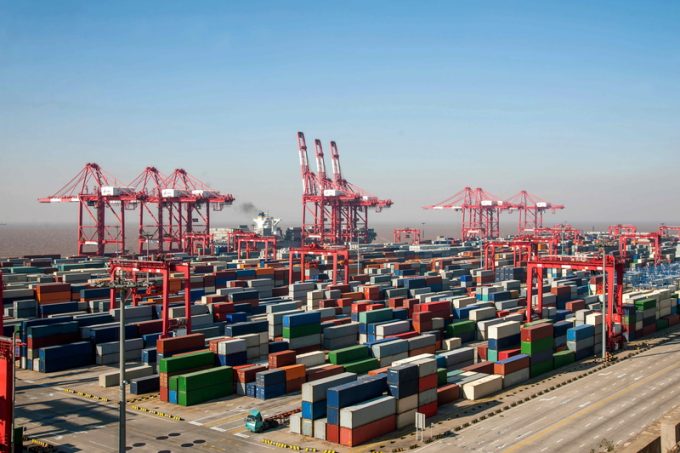Control of Wilson Sons could boost MSC dominance in Brazil
MSC’s acquisition of Brazilian operator Wilson Sons has raised eyebrows among forwarders in the region, ...
GM: RAISING THE ROOF GGM: IN FULL THROTTLE GZIM: MAERSK BOOST KNIN: READ-ACROSSMAERSK: NOT ENOUGHMAERSK: GUIDANCE UPGRADEZIM: ROLLERCOASTERCAT: HEAVY DUTYMAERSK: CATCHING UP PG: DESTOCKING PATTERNSPG: HEALTH CHECKWTC: THE FALLGXO: DEFENSIVE FWRD: RALLYING ON TAKEOVER TALKODFL: STEADY YIELDVW: NEW MODEL NEEDEDWTC: TAKING PROFIT
GM: RAISING THE ROOF GGM: IN FULL THROTTLE GZIM: MAERSK BOOST KNIN: READ-ACROSSMAERSK: NOT ENOUGHMAERSK: GUIDANCE UPGRADEZIM: ROLLERCOASTERCAT: HEAVY DUTYMAERSK: CATCHING UP PG: DESTOCKING PATTERNSPG: HEALTH CHECKWTC: THE FALLGXO: DEFENSIVE FWRD: RALLYING ON TAKEOVER TALKODFL: STEADY YIELDVW: NEW MODEL NEEDEDWTC: TAKING PROFIT

As container spot rates on the Asia-North Europe trade continue to slide, CMA CGM has announced a reduction in FAK rates.
Next month, the French carrier will charge $850 per 20ft and $1,600 per 40ft from $900 and $1,700, and other carriers are expected to follow as they scramble to fill ships.
With demand remaining weak post-Chinese new year, several forwarders have told The Loadstar they have been offered rate discounts in the past two weeks to switch carrier.
UK-based NVOCC Westbound Logistics has suggested carriers are aggressively competing for market share following the introduction of new 22,000 teu ships on the route and is expecting further reductions.
Interestingly however, the recently merged Japanese carrier Ocean Network Express (ONE) continues to publish FAK rates which, at $1,600 per 20ft and $3,100 per 40ft, are substantially out of kilter with competitors.
The bellwether Shanghai Containerized Freight Index (SCFI) recorded another dismal week for Asia-Europe carriers. Spot rates for North Europe tumbled a further 5.2% to $585 per teu and have now fallen by $300 since the beginning of the year, which will be causing alarm bells to ring in the boardrooms of major carriers.
Moreover, the freight rate slide is happening at the same time as carriers are suffering rising bunker prices and a range of other inflationary pressures, including a big spike in ship charter rates.
For Mediterranean ports, the spot rate decline was not as big, at 2.6% to $600. The reason is said to be due to additional demand as a consequence of the Maersk Honam fire and general average delay – the vessel was on an Asia-Mediterranean loop – shippers having to replace and rebook cargo from many of the 7,860 boxes involved.
Elsewhere, there was welcome improvement in spot rates from Asia to the US as carrier negotiators sit down with shippers to finalise new annual contracts beginning 1 May.
Rates for the US west coast ticked up 2.1% to $1,152 per 40ft, while rates to the US east coast were up 2% to $2,192 per 40ft.
Nevertheless, spot rates for the west coast are still around 15% lower than a year ago, and for the east coast some 7% below, which makes carrier negotiators’ task of securing increases, or even maintaining current rate levels, particularly challenging.
But there was some good news for carriers in secondary trades this week – SCFI reported rates to the South American east coast up 22.7% to $2,094 per teu following rate volatility in the wake of alliance restructuring due to Maersk’s acquisition of Hamburg Süd. The jump enabled the SCFI’s composite index to edge up by just under 1% this week, although it is still around 18% lower than 12 months ago.
Comment on this article
Zuidwijk
April 15, 2018 at 11:58 pmThis is a comment on the article of carriers, fighting for marketshare in Far East-Europe trades. Possibly other readers of that article have noticed that, (as always), the SCF-index shows that the highest rates from China, are those to the East Coast of South America (E.C.S.A.). These are the highest rates in the world. And possibly these are the only lucrative rates, which should be a “normal fact” if all things would be normal. But that has been absent in shipping since August 2008, which has cost maritime carriers billions of dollars, in a great part due to their own fault. What I never have read, is how carriers could draw this hat-trick in the East Coast of S.America-trade alone. These carriers are the same megacarriers of the Asia-Europe trades. The explanation of course is, that they all should have done what the carriers to S.America did in the first months of 2015, when little by little they withdrew capacity, which resulted in April 2015 in a total withdrawal of 45 % and rates went sky-high, reaching US$ 3.500,– per box some months later.
Drewry published in 2017, that this was an example for all carriers, but then these should have done this all together, like they did in November 2009, when 10 to 11% of the total container-fleet was idle. But my question is, why did carriers chose the E.C.S.A. trade and no other one. I also wonder why in many programs of Tunnels under the Andes Mountains, (that enormous hurdle for the connection between the east- and west-part of S.A.) , promoters always declare that container-lines from the West Coast of South America offer advantages over E.C.S.A. FOR EXPORTS OF ARGENTINA TO ASIA. Since 1998 you can daily read that Chilean ports declare that Valparaiso is 2.400 nautical miles closer to “ASIA-PACIFICO” than the Port of Buenos Aires, as if “ASIA-PACIFICO” were one fixed point and the earth would not be a globe. China offers the best finance for many projects, one of which will start soon. (It is the project of the Tunnel of “Agua Negra”, between Chile and Argentina in the so-called “Bioceanic Corredor” between the ports of “Porto Alegre” in Brazil and “Coquimbo” in Chile. And in many Chinese charts, you can only see the maritime connection between the whole of South America, from the est Coast of S.America, as if there were no lines to China from the East Coast, which is blatantly confusing. This is my comment.